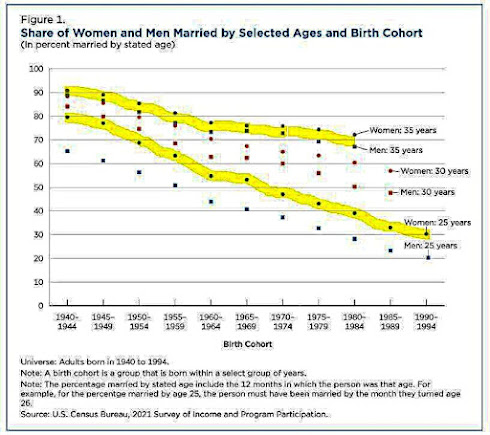The US Census Bureau issued a report roughly two weeks ago on trends in 25-34 year-olds' homeownership between 2000-2019 (link). The report notes that, "The impact on the housing market of the COVID-19 pandemic, which began in 2020, is not captured in this dataset." Even before COVID, however, the trend was not favorable and it is hard to imagine how young adults' rate of homeownership could have gotten better during the pandemic.*
The data we do have show that young adults' homeownership rose slightly and then stabilized between 2000 and 2007. The Great Recession (a large element of which involved reckless and even fraudulent conduct connected to home loans) then clobbered young-adult homeowners (existing and prospective). The percentage of young-adult heads of household who owned their homes (as opposed to renting), which had been in the mid-40 percent range as of 2007, declined to the mid-30 percent range as of 2015. As of 2019, this rate had inched up only to the high 30s. Naturally, as homeownership began to decline, renting began to rise. Here's a screenshot from the report...

The report next discussed young adults' homeownership in relation to education (Figure 2, not reproduced here). Interestingly, in the very early 2000s, young adults whose highest educational attainment was a bachelor's degree (or higher), some college, and a high school diploma all owned homes at similar rates (mid-high 40s), with those having less than a high school diploma lagging. By 2019, however, appreciable gaps in homeownership had opened up between educational categories (bachelor's-plus clearly exceeding some college, some college clearly exceeding high school graduates, etc.).
Lastly, the Census report discussed racial-ethnic differences in homeownership. Looking only at 25-34 year-olds with a bachelor's degree or higher (to hold education constant, permitting a more direct focus on race-ethnicity), we see that racial disparities still exist. As of 2019, approximately 50% of young adults who were White (either Whites overall or more specifically non-Hispanic Whites) owned their own home. Hispanic/Latinx, Asian, and other-race young adults were in the mid 30s, whereas African Americans were in the mid 20s. Remember, the educational status of all these groups was held constant.
I suspect that these disparities represent some combination of racial-ethnic discrimination (in hiring, so that minorities make less income, and in lending) and White parents having more money, on average, to help their grown children out with a down payment.
One issue I would like to see addressed within the US context is where young adults are living or trying to live. Large cities such as New York, Boston, Washington DC, Chicago, Los Angeles, and San Francisco, along with "hot" up-and-coming markets such as Austin and Nashville, have become expensive for everyone, but especially young adults. Other places such as Lubbock, Texas, and West Lafayette, Indiana, are not as expensive. Will young adults continue to gravitate to large cities -- where multiple roommates are often required even to live in an apartment -- or might there be an increase in young adults seeking out smaller towns?**
---
*In fact, there has been a lower rate of independent living for young adults during COVID. According to a report from the Pew Research Center, a few months into the pandemic (July 2020), the "share of 18- to 29-year-olds living with their parents [had] become a majority..., surpassing the previous peak during the Great Depression era." Others have pointed out that the percentage of grown children living with their parents returned to more typical levels as COVID restrictions eased. However, the financial, educational, housing, and other forms of disruption during COVID would not seem conducive to young-adult homeownership in the near future.
**As an aside, one of my favorite neighborhoods in the whole country is Wrigleyville, by the Chicago Cubs' baseball stadium Wrigley Field. I wrote a chapter about the neighborhood in the Society for American Baseball Research book Wrigley Field: The Friendly Confines at Clark and Addison (G. H. Wolf, editor). In it, I noted that despite "Wrigleyville housing [costing] 2.2 times as much as the Chicago average," 20-29 year-olds comprise 31.5% of residents within the ZIP code containing Wrigley Field (the third-highest percentage of young adults within any Chicago ZIP code).



